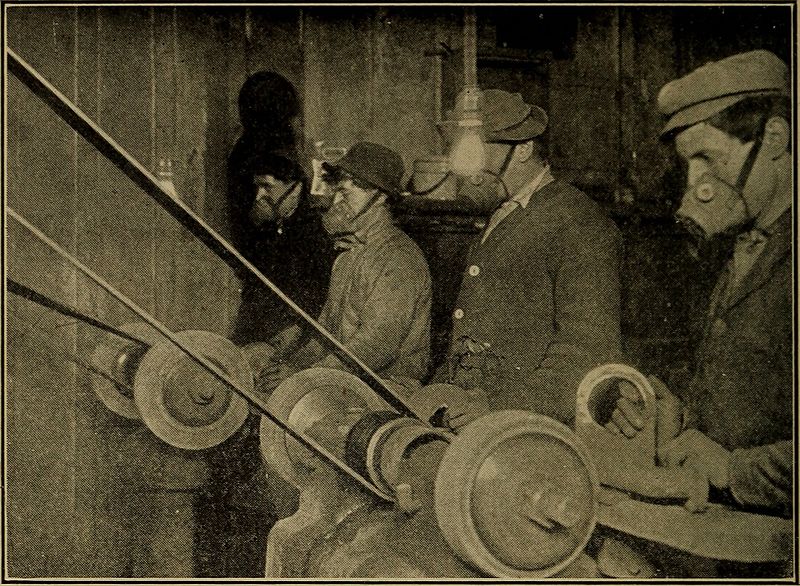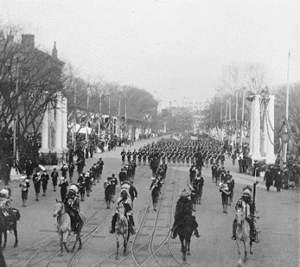For the average American, having a job is an essential aspect of life; without a stable source of income, it is nearly impossible to survive in today’s world. Working during the 1900’s was not as easy it may seem at first look. Although it is true that there were many new jobs available in factories, working in them posed many significant consequences for the employees. Working was more difficult than expected, Americans suffered from working extreme hours around heavy machinery, which made fatalities skyrocket. The government did eventually pass labor laws, but it could not undo the difficulties people had faced.
These laws were meant to maintain the health of workers while providing them safety and compensation for work-related injuries.1 The working conditions of factories produced many hardships for Americans. The pay was barely enough to feed one mouth, so it was rather impossible to feed a whole family. In today’s society, minimum wage employees complain about getting paid $7.25 per hour, but there was no minimum wage in 1900. The average person today works 40 hours per week, which is $290 per week at minimum wages. Most paychecks are handed out every two weeks; therefore, most Americans can make up to $580 in one paycheck. In 1900, the average American worker was paid a measly $400-$500 over the span of a year; this is less than the typical American makes in one paycheck today. Even adjusted for inflation, a higher percentage of Americans lived in poverty then than they do today.2
Although some people believed that only males should hold jobs, there was actually an increasing number of females and children being employed in the workplace. However, the women and children being hired were typically not prepared for career choice jobs, forcing them to work in factories. Factories took advantage of individuals that would work for lower wages without outcry; more often than not, these individuals were comprised of women and children that were desperate for the opportunity to bring any form of income into the household, not realizing that their lower pay may decrease the pay that the father of the house received.3
By 1900, almost 17 percent of females comprised the industrial workforce, most of whom were single and trying to support themselves, their children, or their siblings.4 The women who typically worked were usually white and tended to be under the age of twenty-five; however, a vast majority of workers were the daughters of immigrants or were immigrants themselves.5
The main workplace for women was in the textile industry; this was because most women could not handle the heavy manual labor like men could. In these factories, women typically were paid wages of $6-$8 per week, causing their average income to fall well below the average wages for men. With such a low paycheck, most women found themselves in poverty, and some were forced with no other option besides prostitution.6. Another issue with women working is that society believed that it was wrong for women to be in the workplace and out of the household; so the women who had to take up a job were scrutinized. This view on women working did change over time, with the majority of communities seeing married, employed women as a strong figure, opposed to being the quiet, nurturing, and delicate character that was expected of them.
Due to such low income, most family members were forced to get jobs. This meant that when the man could not solely support the family, women had to step up. When even this did not produce the amount of money needed to sustain the family, children were next in line to find a job. Children that tended to work were often from families whose husbands denied the right for their wives to work; so they helped provide for the family so their mother did not have to work. At least 1.7 million children under the age of sixteen were employed in factories or fields by 1900. About 10% of girls were the age of 10-16 and boys made up 20% of all ages of employed workers.7 Unlike the wives in the textile industry, most children found themselves working in agriculture for an average of twelve hours a day, performing arduous tasks such as picking and hoeing the fields.8 Children in the South usually worked at night, with employers keeping them awake by throwing cold water in their faces. The majority of female children had to cut fruits and vegetables for sixteen hours a day. Even though laws were passed to protect children, they were still vulnerable to getting severely hurt while working; some of these injuries turned fatal quickly.9

Other hardships Americans faced was the amount of hours that made up a typical working day. Most Americans had to work 10-12 hours, six days a week. If they worked in the steel industry, the typical working day consisted of 12 hours.10 The hours may not have seemed so bad, and many of us may have already worked that long for a shift, but the working conditions they were subjected to at the time made it much more difficult. The conditions were labeled as unfit and unhealthy for humans and working for long, exhausting hours did not help reduce the number of injuries. There were several accidents that ended in tragedy, labeling factories as unsafe for working. Although injuries were common, it was very rare for a victim of these on-the-job injuries to receive any type of compensation from their employers or the government. Eventually, workers lost control of the conditions for their labor. With this loss of control, more problems appeared, including already low wages being lowered further and long hours turning longer.
Having a job was never an easy task to maintain in the past. Through the difficult times, Americans did not give up; they fought through the struggles to create a successful life. In the end, one can say the labor challenges were worth the struggle because over time, the United States has significantly improved the laws that we see enacted today that are used to protect all individuals working, as well as protecting children from being subjected to work at young ages.
- “Labor Laws and Regulations,” Monthly Labor Review 7, no. 4 (1918): 240. ↵
- Alan Brinkley. American History: Connecting with the Past Volume 2, 15 edition (New York, NY: McGraw-Hill Education, 2014), 477. ↵
- Alan Brinkley. American History: Connecting with the Past Volume 2, 15 edition (New York, NY: McGraw-Hill Education, 2014), 477. ↵
- Alan Brinkley. American History: Connecting with the Past Volume 2, 15 edition (New York, NY: McGraw-Hill Education, 2014), 477. ↵
- Alan Brinkley, American History: Connecting with the Past Volume 2, 15 edition (New York, NY: McGraw-Hill Education, 2014), 477. ↵
- Alan Brinkley, American History: Connecting with the Past Volume 2, 15 edition (New York, NY: McGraw-Hill Education, 2014), 478 ↵
- Alan Brinkley, American History: Connecting with the Past Volume 2, 15 edition (New York, NY: McGraw-Hill Education, 2014), 478. ↵
- Edward N. Clopper, “The Federal Child Labor Law,” The Elementary School Journal 17, no. 5 (1917): 327. ↵
- Albert J. Beverage, “Child Labor Laws,” The Journal of Education 68, no. 12 (1908): 330. ↵
- Alan Brinkley, American History: Connecting with the Past Volume 2, 15 edition (New York, NY: McGraw-Hill Education, 2014), 477. ↵



46 comments
Alyssa Valdez
I always enjoy reading articles about working conditions and comparing them to know. I also thought your article was very interesting and can tell you put a lot of time into writing your article. I think it is so unfortunate that so many people had to work through terrible working conditions barely making anything just to support their families. It just goes to show how much we have progressed as a society.
Nelson Smithwick
As someone looking to pursue a career in Occupational safety, this article really interested me. We’ve made such great strides since these days in both the safety and the treatment of worker, as the conditions in those days were deplorable. Women and children who worked in smokey, hot sweatshops, men who worked on skyscrapers, without scaffolding or tethers were situations that were all to common in the early United States’ industrialized workplaces.
Faisal Alqarni
I enjoyed reading your story. I t does seem that those who presently work in the present day labor market have a lot to be grateful for to those who came before them and suffered doesn’t it? I mean looking at the difference in pay alone it shows this. But still the living demands of present times they have led to the 15 dollar per hour demand by low skill workers showing the problems of the past have not really gone away even if improvements they are there. However, the gains made they are still great I feel especially happy about the ending of child labor in America I do hope that in other countries this practice also ends in near future.
Teresa Valdez
It is amazing how far the country has come since 1900. Although things still might not be perfect, it can be said that conditions are improving. In this way, this article was very enlightening as to how society has evolved. Supporting a family seems so much easier in comparison to the past. Society’s outlook on getting jobs made feeding a family that much more difficult. This article made me thankful that I live in a more accepting time period.
Samuel Sanchez
It’s surprising how harsh the working conditions were compared to how they are now. It’s funny how people still complain but I guess nothing is perfect. Back then, people did not have the privilege to work in a field that they loved, they just worked to survive. I’m glad they changed the laws to where people today won’t suffer as greatly as they did back during the 1900s.
Justin Sassman
its surprising how we take the working coonditions of today for granted compared to what they where in the past, like we have a minium wage health care and days of and holidays while back then there was non of that you work for little to nothing and cant complain becuase your doing it for loved one or survival, while we dont have to worry about it as much as of today.
Nahim Rancharan
The article does a great job at analyzing the progress that has been made within the labor sector.Although what most people tend to see are the positive aspects and benefits of labor within this time, it is hard to ignore the harsh realities that surrounded this sector. It is important to realize the struggles that people of the past have made in regards to things like women working within industries and preventing the manipulation of child labor so as to appreciate the progress made in today’s society. This article effectively highlights these struggles. Job well done!
Marissa Gonzalez
It is very unfortunate how extreme working conditions used to be. This article is well written to represent the struggles of Americans and their desire to be financially stable. It is a good thing that laws have changed and set conditions on minimum wage and worker’s compensation. It is hard to imagine children working in harsh conditions at such a young age for long periods of time with little pay. This article really compares today’s work force and how much it has changed since then.
Oscar Portillo
This was a good article to read due to the fact that minimum wage and wage in general has been an issue of debate since the late 1800’s and will continue to be so for the foreseeable future. It’s unfortunate that these atrocities happened to women and children but there was a silver lining in all of this in that it paved the way towards new legislation to change this. I have mixed feelings about this article due to the commentary on housewives. The reason for this is due to the fact that my mother was a housewife and it is not as easy as one would think. In essence, being a housewife had and has its own challenges and science to it. In conclusion, life for a woman born in the middle and lower class must have been unimaginable by present standards. Hopefully, as a society, we learn from this dark chapter in history.
Mario Sosa
It is ridiculous how people used to work so much for so little, especially under harsh conditions. I do not see how anyone could manage to live through their whole life like that. After seeing what working was like in the 1900’s, I wonder what the average American workplace will look like a hundred years from now. Very informative and detailed article. Job well done!